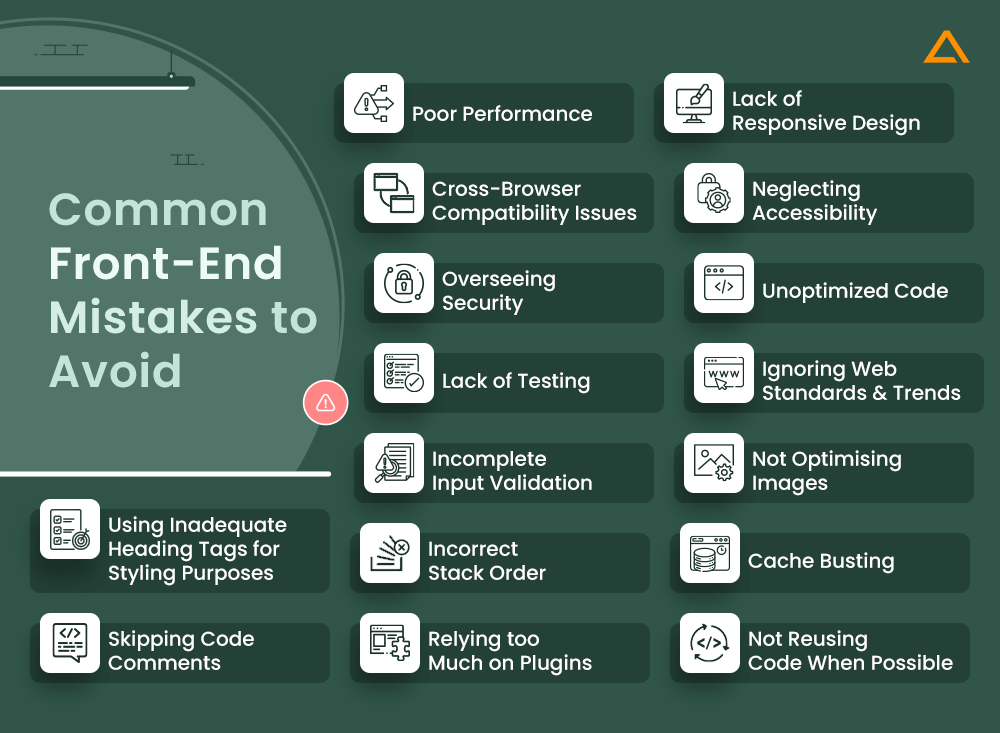Quick Summary:
Avoiding common front-end mistakes is crucial for building high-quality websites & applications. Enhance your front-end development expertise by avoiding these mistakes. By understanding and sidestepping these pitfalls, developers can ensure their front-end solutions are efficient, user-friendly, and successful.
In order to shape how users, interact with websites and applications, front-end development is crucial. layout, aesthetic components, and responsiveness. How people browse and view a digital product is the responsibility of front-end developers.
Even seasoned developers occasionally make simple errors that degrade performance, usability, and user experience. In this blog post, we’ll look at some of the most common front-end errors and offer tips for avoiding them. Developers can create front-end solutions that are more effective, accessible, and resilient, delight users, and help their digital products succeed by being aware of and avoiding these traps. Let’s get started and learn the common front-end errors to avoid. But first, consider the importance of preventing front-end errors.
Significance Of Avoiding Common Front-End Mistakes
There are several reasons why front-end errors should be avoided, and they can have a big impact. Some of the most important factors and their related effects are listed below.

User Experience
Front-end errors can directly impact a website or application’s user experience. Increased bounce rates can be caused by user annoyance brought on by poorly designed or unclear interfaces, long loading times, malfunctioning features, or inconsistent behaviour. Contrarily, a slick and straightforward user experience can increase user pleasure, engagement, and conversions.
Brand Reputation
Often, a user and a brand initially interact with each other through a website or mobile application. A brand’s professionalism, dependability, and attention to detail can all suffer from front-end errors. The brand’s reputation could be harmed if users believe that a poorly designed or broken interface must be improved to maintain quality and reliability.
Conversion Reputation
Keep in mind that front-end errors may have an immediate effect on conversion rates. Users are less likely to perform desired tasks like making a purchase, signing up, or completing a form if they encounter hurdles, confusion, or annoyance while navigating a website or application. Increase conversion rates and accomplish business objectives by eliminating errors and giving users a flawless experience.
Performance & Accessibility
Front-end errors might significantly impact the performance and accessibility of a website. High bounce rates and a bad user experience can be brought on by bloated code, too many server requests, and slow-loading pages. Additionally, accessibility errors might make it difficult for people with impairments to access and navigate the website, such as incorrect use of alt tags or a lack of enough contrast. The performance is enhanced, and inclusivity is ensured, by addressing these problems.
SEO & Organic Traffic
Front-end errors can negatively affect SEO performance because search engines consider many different aspects when determining how to rank websites. For instance, slow-loading sites, incorrect heading tag usage, or broken links might impact organic traffic and search engine exposure. You may raise your search engine results and increase organic traffic by avoiding these blunders and adhering to standard practices.
Now that we understand the importance of avoiding front-end errors. Let’s start with typical front-end errors to avoid.
Common Front-End Mistakes to Avoid
Without further ado, let’s elaborate on the common front-end mistakes that developers often encounter at the initial stages of development.

Poor Performance
Poor performance can damage the user experience when it comes to front-end development. Users with lengthy loading times may become irritated and leave a website or service. For us to optimize and give a seamless experience, we must first understand the typical reasons for performance concerns.
Poor performance can significantly impact the user experience of a website or application.
Let’s dissect them so that we can comprehend them better:

Excessive use of JavaScript
Excessive JavaScript consumption is one of the most frequent causes of bad performance. Large JavaScript files can dramatically slow down a web page’s loading time, particularly on slower devices or network connections. Reviewing and optimizing JavaScript code is crucial, eliminating any extraneous processes or scripts if needed. JavaScript files can be made smaller and load faster by being minified, which removes whitespace and comments.
Over-the-top use of Large Files
Utilizing huge files is another element that affects performance. Improperly optimized images can slow down the rendering process. Developers should consider scaling photos to the right dimensions and compressing them without sacrificing quality to help avoid this. Contemporary picture formats like WebP can also be employed to reduce sizes and speed up loading.
Excessive network requests
Excessive network requests can also hamper the performance. The server must process and retrieve the needed resources for each request, which takes time. Whenever possible, it’s crucial to reduce the number of network requests by merging files like CSS and JavaScript into a single file. Furthermore, caching techniques can enhance performance by locally storing frequently visited resources on the user’s device and avoiding repeated queries.
Lack of Responsive Design
When front-end development needs more responsive design, users experience a subpar interface on different devices. Websites and applications may appear distorted, making navigation difficult and frustrating. To address this, developers must prioritize responsive design principles, employing fluid grids, touch-friendly navigation, and testing across devices.
CSS media queries help adapt layouts and styles, while responsive typography and flexible images ensure seamless content adjustment. By embracing responsive design, developers create consistent user experiences across desktops, tablets, and smartphones, enhancing usability, engagement, and overall satisfaction in today’s mobile-driven world.
Cross-Browser Compatibility Issues
Issues with cross-browser compatibility rank among the most important issues in front-end development. The website and application can behave and display differently among browsers.
Developers should follow best practices including writing clean code, performing numerous tests on different browsers, and keeping up with compatibility changes in order to resolve this issue.
Prioritizing cross-browser compatibility guarantees consistent user experiences, boosts satisfaction, and increases accessibility to a larger audience using different browsers.
Neglecting Accessibility
People with disabilities may not be able to access or use certain websites or applications if accessibility is neglected during front-end development. It is unethical and maybe illegal to emphasize accessibility when doing so.
Developers should follow accepted standards like WCAG, include accessible design elements, provide alternate text for images, ensure keyboard navigation, and carry out frequent accessibility testing to remedy this.
Developers who prioritize accessibility produce inclusive digital experiences, guarantee equitable access for all users, and show a dedication to diversity and usability.
Overseeing Security
Vulnerabilities, data breaches, and unauthorized access can result from front-end development practices that ignore security. To reduce risks, programmers must use safe coding techniques, like input validation and parameterized queries, to thwart widespread attacks like XSS and SQL injection.
User accounts are more secure when properly authenticated, encrypted, and multi-factor authenticated. It is essential to develop secure communication protocols, keep software dependencies up to date, and regularly test for security.
By prioritizing security, developers safeguard user information, uphold user confidence, and reduce the risk of threats to websites and services. Constant protection is ensured by remaining informed, implementing best practices, and performing security audits.
Also Read: Top Javascript Frameworks in 2024
Unoptimized Code
In front-end development, poorly optimized and structured code can lead to performance problems, upkeep problems, and a higher chance of defects. Code optimization increases performance and efficiency by removing redundancy, enhancing algorithms, and encouraging code reuse. Improve readability and teamwork by creating a structured and well-defined code base with appropriate concern separation and naming standards. Regular code audits and refactoring aid in locating and fixing optimization and structure problems. Performance, maintainability, and overall development efficiency can all be improved by developers by giving efficient code and sound structure priority.
Lack of Testing
Your website or application may have undetected bugs and functional issues by skipping appropriate testing throughout front-end development. In order to guarantee quality and dependability, testing is essential. It consists of user acceptance, integration, and unit testing. Developers can find issues early and lower the possibility of deploying flawed software by embracing testing from the start, establishing test cases, and employing automation tools. The finished product’s overall quality and user satisfaction are improved by including users and stakeholders in the testing process.
Ignoring Web Standards & Trends
The functionality, compatibility, and user experience of websites or applications might suffer if web standards and trends are disregarded during front-end development. Web standards promote accessibility and cross-browser compatibility while guiding coding procedures. Ignoring them may result in the faulty design, unpredictable behaviour, and poor usability. Additionally, paying attention to current online trends can lead to outdated designs and functionalities, making an application feel antiquated or less appealing to consumers. Developers may produce cutting-edge, user-friendly, and future-proof front-end solutions that satisfy user expectations and industry requirements by remaining updated and adhering to web trends and standards.
Incomplete Input Validation
You must validate user input both on the client and server sides. It is well-recognized that you shouldn’t believe what users say. However, that doesn’t preclude errors from occurring during validation. SQL Injection is one of the most frequent effects of this error and is always covered by OWASP 10.
Keep in mind that many front-end development frameworks include extremely user-friendly out-of-the-box validation rules. Additionally, the most of significant back-end development platforms employ straightforward annotations to guarantee that given data complies with expected standards. Validation implementation may take some time, but it should always be a part of your routine coding procedures.
Not Optimising Images
Visuals rule the digital world in which we live. Utilizing visual aspects in web design is required due to the widespread use of high-speed internet and the increase in smartphone use. In front-end design, images play a crucial role. Even so, many developers need to optimize photos before publishing a project.
When you conduct project development in a local setting, you will observe that everything loads at a lightning-fast rate. The use of bandwidth is simple to overlook, yet poorly optimized graphics are a big issue.
The creation of a reliable procedure for optimizing photos must be given top priority during front development. Use contemporary picture formats like WebP and AVIF instead of JPEG and PNG. Google claims that WebP offers 25–34% more compression than JPEG. Utilize tools like ImageOptim and SVGO for image optimisation at the server level.
Using Inadequate Heading Tags for Styling Purposes
A frequent error in front-end development that can have a detrimental impact on accessibility and SEO is the use of insufficient header tags for styling. Content hierarchy and page organization are greatly aided using heading tags (h1–h6). Screen readers can be misled by the misuse of heading tags when they are used only for styling, and it can be challenging for users to browse and comprehend the information. It may also influence search engine results because search engines use heading tags to determine the organization and relevance of the material. To achieve good accessibility and SEO optimization, it’s crucial to employ heading tags effectively and CSS for styling.
Incorrect Stack Order
It is common to require to overlap different pieces while creating more intricate components, such as navigation. To tell the browser where these items belong in the hierarchy, a z-index property is applied to them. A page might easily feel broken if an element’s z-index property is off, which will prevent visitors to your website from departing.
Cache Busting
Your styles can benefit from caching on your website, which will help to speed up load times. After altering your styles, don’t forget to update the CSS cache buster or you’ll get several display problems. (Unless the process has already been automated.)
The reason behind this is that the browser believes it already has the file in its cache and therefore doesn’t need to re-fetch it. This may significantly affect your website, depending on the changes you made to your designs.
By replacing the UNIX epoch value with the current one in the href on your tag, you can quickly add a cache buster to style links by adding?_=1512598593150.
Skipping Code Comments
Leaving code comments is one of the important coding best practices. But unfortunately, a lot of developers have admitted that they more than often skip leaving code comments. That is the big mistake, code comments not only help you in code maintenance, but it also helps in understanding what the code does. Apart from this, it is most helpful in finding bugs faster in your code.
The comments are also helpful to the developer that is going to read your code, as they are helpful to yourself. Use comments to notify, update or even warn other developers about the importance of your code and its core functionalities.
Relying Too Much on Plugins
Plugins play a crucial role in WordPress. It is your responsibility as a developer to take advantage of them when necessary and when they can improve user experience on the website or lighten your workload. A plugin can be installed by anyone, even those with no prior knowledge. It’s a widespread deception that adding a plugin will simplify things. It’s accurate to a certain extent. However, as is often the case, using too many plugins can be hazardous. These plugins need to be updated and maintained. As was previously said, using too many plugins can cause a website to run slowly or even crash. Use them sensibly to avoid this.
Not Reusing Code When Possible
One of the most common front-end mistakes that developers can make is not utilizing the code when it is possible. Often there is reusable code that you can use. It is not required to make the wheel again every time you need it. In the same one, once you have successfully developed a functionality you can reuse it, it’s not stealing it’s just optimizing your workflow.
Let’s take an example for a better understanding of this. Once you have developed a payment integration model that’s working properly, you don’t have to develop it again when you must use it in any other project. You can reuse the same code in another project by making the proper required changes.
Popular Front-End Technologies Mistakes
Up until now, you have seen common front-end mistakes that you should avoid. Now let’s look at the popular front-end related mistakes but with respect to the popular technologies.
Let’s begin with JavaScript and continue with React and Angular:
JavaScript
Following are some of the common front-end mistakes in JavaScript:

Working without a Coding style guide (rules)
It is essential to define a coding style for your project, to ensure a consistent coding style and avoid common JavaScript errors. This can be achieved by using a linter like ESLint. By configuring ESLint with a specific set of rules, you can enforce coding standards across your team. For example, both Standard and Airbnb provide popular coding styles with their own set of rules. Here’s an example of using ESLint:
// Standard style - Example
const greeting = "Hello,";
const name = "John";
console.log(greeting + " " + name);// Airbnb Style - Example
const greeting = "Hello,";
const name = "John";
console.log(`${greeting} ${name}`);In this example, both styles are doing the same thing, which is generating the greeting message with the name. In standard style, string concatenation is performed using the + operator, combining the greeting and name with a space in between.
In the Airbnb style, template literals are used, denoted by the backticks (`). The greeting and name variables are interpolated directly within the template string using ${} placeholders.
Both styles achieve the same output, but the approach to string concatenation differs slightly. These nuances reflect the specific rules and conventions enforced by each coding style.
Looking to Hire Dedicated JavaScript Developers?
Trust offshore JavaScript developers from Aglowid to develop robust web and mobile apps that can accelerate your growth.
Using magic values
In many languages, using magic values is a common error, but in JS, you should avoid it. First, a magic value is considered a constant value that appears arbitrary in the code. It can be explained only be explained by the one who has written the code and it can happen that they might also forget.
Example:
with magic values
const specialFn = (r) => {
const fnValue = 2 * 3.1416 * r; // not clear :/
return fnValue;
};
console.log(specialFn(4));the right way
const PI = 3.1416
const specialFn = (r) =>{
const fnValue = 2*PI*r // Looks like circumference :)
return fnValue
}
console.log(specialFn(4))That approach basically applies to everything that could be considered a constant, not only numbers but to names, prefixes, and more.
Memory Leaks
JavaScript mistakes that result in memory leaks are frequent, and they can affect your application’s performance and cause strange behaviour. Unintentionally keeping references to things in memory prevents them from being garbage collected even after they are no longer required. These accumulating memory leaks slow down the performance of your application over time by causing it to use an excessive amount of memory.
Below mentioned are some of the examples for creating memory leaks and how to avoid them.
Event Listeners
It is common for memory leaks to happen when event listeners are attached to DOM elements. The event listener function will keep referencing the element even after it is no longer required, preventing it from being garbage collected. If you don’t remove the event listener when the element is no longer required. If you want to prevent this, be sure to use the removeEventListener method to delete event listeners after you’re done with them.
// Creating a memory leak by not removing the event listener
function handleClick() {
// ...
}
document.getElementById("myButton").addEventListener("click", handleClick);
// Correct way: Remove the event listener when no longer needed
document.getElementById("myButton").removeEventListener("click", handleClick);setInterval and setTimeout
Memory leaks can also occur if timeouts or intervals are not cleared. Make careful to use clearInterval or clearTimeout to remove any scheduled recurring or delayed activities if you used setInterval or setTimeout to create them.
// Creating a memory leak by not clearing the interval
let count = 0;
function increment() {
count++;
console.log(count);
}
const intervalId = setInterval(increment, 1000);
// Correct way: Clear the interval when no longer needed
clearInterval(intervalId);
Disregarding object mutability
Contrary to what some people think, the word “const” does not indicate that an object cannot be changed. Mutability is still a problem, though. There are numerous other factors to consider if you wish to be more stringent with mutability. For instance, because it involves several copies of altered data, the usage of this mutability strategy necessitates more storage capacity. Even though functional programming methods frequently employ this strategy, it’s crucial to understand the spatial complexity in order to prevent memory leaks.
Also Read: Micro Frontend Architecture 101
React
Following are some of the common front-end mistakes in React:

Absence of micro-services
One of the most frequent errors made by beginners is compiling everything into a single file. In doing so, they produce an app with a monolithic structure that is challenging to handle and debug due to everything being in one location. Making separate components is the greatest method to prevent it and ease the pains of future developers who will work with such code. These elements can be imported later and combined to produce the app page that is required. Additionally, by breaking everything down into individual components, you may update and debug each one in the safest possible manner.
setState() is asynchronous
Since even seasoned coders occasionally forget about it, it makes sense that a rookie would do the same. What does the term “asynchronous” mean in setState()? This implies that not all of the changes you make will be seen at once. They would rather move to another render and then be seen. Additionally, React will automatically batch the update calls, which will enhance performance. As a result, if you attempt to obtain a state value and forget about setState() and its asynchrony, you will undoubtedly get undesirable outcomes.
Components name capitalization
The names of components are occasionally not capitalized by React developers. Despite how minor the error is, it is quite simple to make. There will be some mistakes, but nothing seriously harmful. As an illustration, an HTML tag is denoted in JSX when a component is written in lowercase. You will certainly encounter an error stating that “your component name” is not a valid tag. Simply substituting a capitalized letter for the component’s first letter will solve all your problems.
God Components
Monolithic, non-reusable parts make up the parts of God Components. When building a page, avoid cramming every UI element into a single component. Instead, take the time to outline all the connected aspects of your project and make each one into a unique component. When components are split in this fashion, all your program’s components are easier to keep up with and restructure as necessary.
Angular
Following are some of the common front-end mistakes in Angular:

Direct DOM Manipulation
Direct DOM manipulation in Angular is a common mistake. It bypasses Angular’s change detection system, leading to inconsistencies between the application state and the DOM. This approach hampers code reusability, maintainability, and security. Angular encourages a structured approach using components, templates, and data binding, providing better code organization and readability.
By following Angular’s best practices, developers can build scalable and secure applications while leveraging the framework’s features and benefits. Avoiding direct DOM manipulation ensures proper integration with Angular’s application model, resulting in a more maintainable codebase.
Using jQuery
Using jQuery, which is again connected to DOM Manipulation, is another one of the fundamental Angular errors. Even though Angular and jQuery share the same parent, JavaScript, they were created for different purposes and cannot be compared on the same scale.
Developers sometimes rely on jQuery rather than the many other, superior functionalities offered by Angular. The issue with this is that if you remain with jQuery, the framework won’t be aware that the DOM has been altered by jQuery.
This means that some undesirable effects will occur when it renders and compiles the application interface. And to make matters worse, you might need to be made aware of the source of these errors because you chose the incorrect DOM manipulation method.
Using Client-Side Pagination
Data rendering is a technique businesses use that employs Angular functions to keep the bulk data within the application. They employ client-side pagination for data rendering, which is a good method—but only when there is less data—to load the application.
Large volumes of data make things challenging because client-side pagination renders all the data in its entirety. This adds to the time and workload, which amounts to another Angular mistake you can encounter.
The alternative is to employ server-side pagination, particularly when rendering huge volumes of data. Using this technique, you can load any data needed to provide clear instructions or render a certain page number.
Failing to Organize the Codes
Mastering code structure in Angular requires practical experience. With the abundance of Angular functions to program, the scripting code tends to increase, making it challenging to organize longer scripts. However, code organization is crucial and should be considered. The MVVM architecture used by Angular adds to the code volume, putting strain on the controllers. It is important to avoid excessive code insertion and writing to maintain manageability and facilitate testing. Breaking the code into modules not only aids in fault discovery but also enhances the overall aesthetics of the code.
Wrapping Up!
This brings us to the end of the common front-end mistakes to avoid. Although front-end development might be difficult, avoiding these frequent blunders can result in more effective and user-friendly websites and applications. Developers may produce top-notch front-end code by optimizing for performance, testing on many platforms and browsers, emphasizing accessibility, adhering to best practices, utilizing version control, utilizing responsive design, and taking SEO into account.
have a unique app Idea?
Hire Certified Developers To Build Robust Feature, Rich App And Websites





 Say
Say